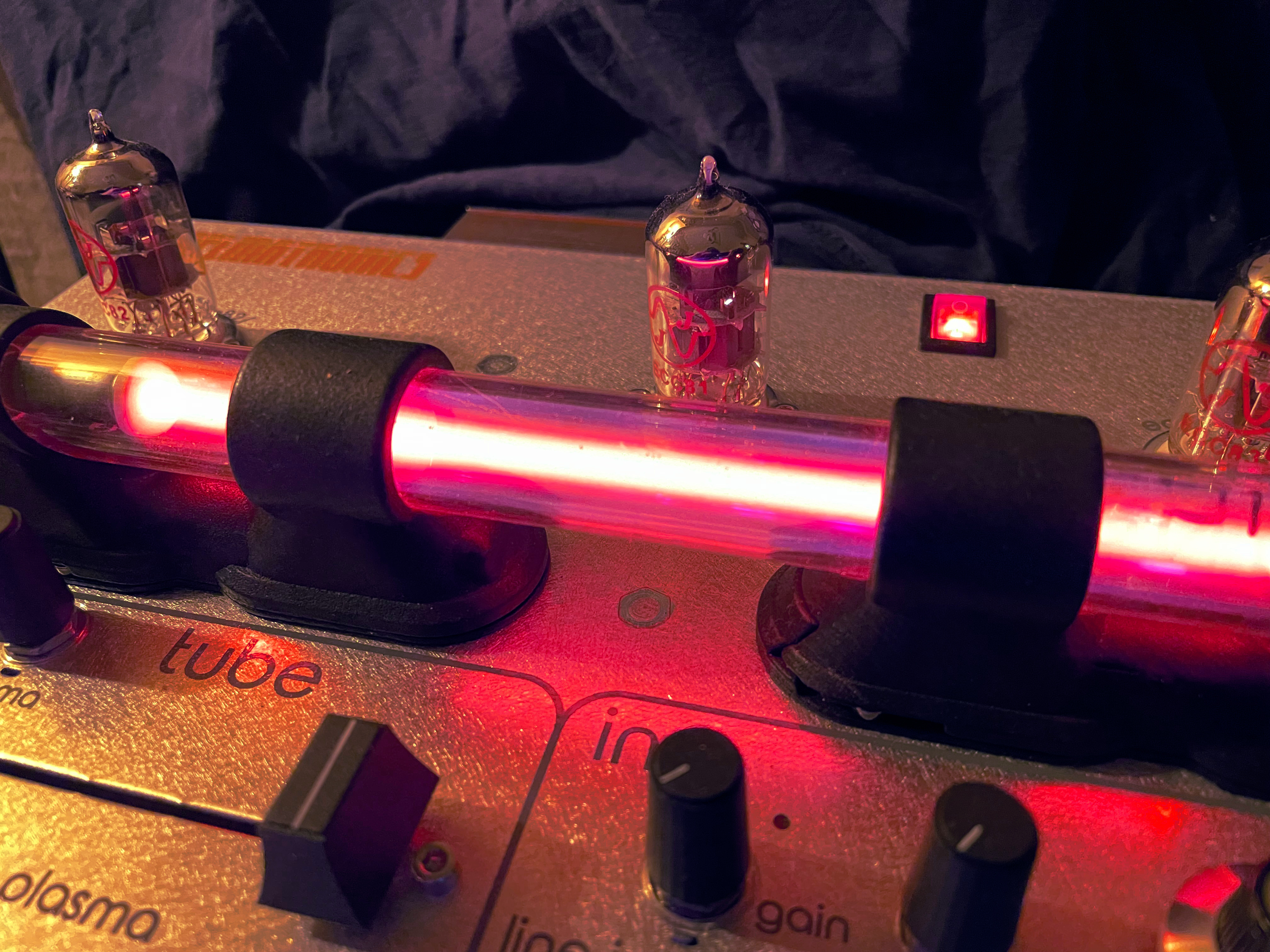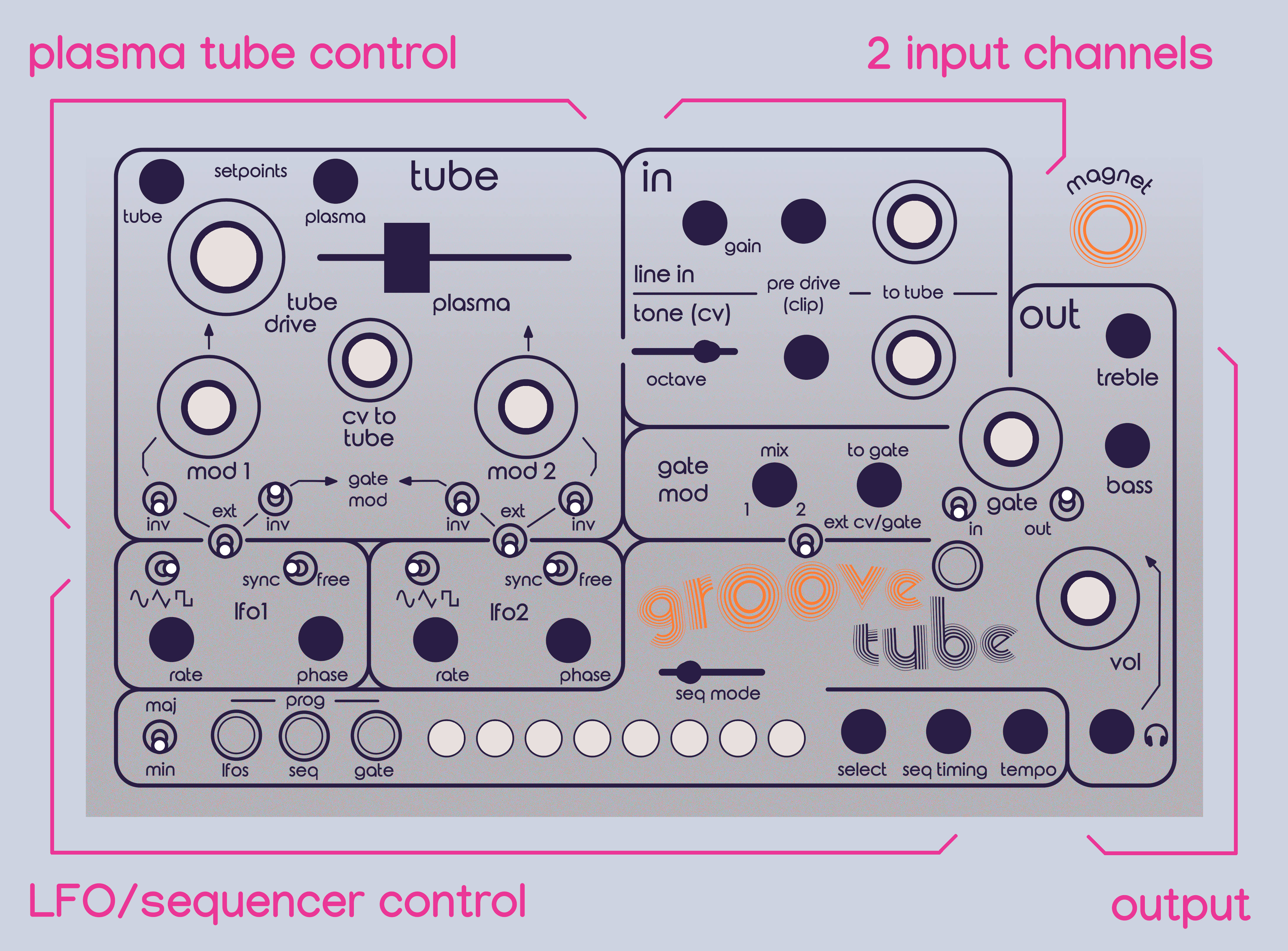Groovetube synth

Groovetube is finally a complete instrument!
It took a while to interface different parts of the circuit properly, and get all the signals working well on a pcb. The hardware is now done, and last firmware is being written.
We have a good idea of production costs, and are able to take a small number of orders. Initial availability is unfortunately limited by the disappearance of fluorescent tubes - please see below.
Overview
The synth works by exploiting the different sounds produced around the edge of plasma stability. It is like a valve pre-amp with a plasma tube in the current supply line, and a separate voice oscillator to create an input signal.
The input signal modulates voltage and current through the tube and its RF supply. This produces output sound in similar fashion to a conventional amplifier, but with the noise created as current passes through the tube modifying/interacting with the input signal.
The noise boundary can be varied by either the RF stabilisation or a magnet, and can be directly affected by the input level. Audio output is coupled directly from one end of the tube - there is no 'dry' or pass-through component.
Two input channels are mixed down before being sent to the tube system. One of these is reserved for the tone generator, the other for audio line-in. Controls for input, plasma tube and output are grouped on the interface:

Demos
We now have a final-spec machine built up, with most of the control firmware written.
So far we have recorded a few clips testing the line-in, and a couple that show oscilloscope traces of the input/output signals. More demos to come as soon as possible!
This is the most recent demo recorded:
A bit of chaos-at-the-controls testing the code for sequencer transport and octave switches. Scope traces show the difference between signal input to the tube and audio output. The audio recording quality is better than in previous demos.High-quality audio version 54MB download
Versions of the following clips are also available with WAV audio, but suffer from poor recording quality.
Plasma fluctuations can make some pretty crazy waveforms, like alternating long/short periods and repeating irregular patterns. In the clip below, tube drive is varied with each note, and you can see different types of waveform interacting with the input tones. Plasma has a volatile, non-linear response to drive conditions, so the system doesn't always produce quite the same result.
high-quality audio version 20MBThe next clips show line-in tests - in some the synth is running a Fusion brand fluorescent, in others a prototype neon tube. Fluorescents generally tend to add higher-frequency noise, and can produce a very brassy sound. The neon tube is not quite suited to this machine, it really needs more voltage to produce much plasma noise. Run like this it adds warm distortion and definition to the sound, which is encouraging for the next versions.
We have not tested many audio sources yet, but got good results with first sending a signal from the radio or drum machine through a Wingie2 resonator. This boosts certain frequencies of the input, making a compressed/saturated signal that the plasma responds well to - though the output level can vary significantly as input frequencies change.
Three clips showing sounds from live radio put through the resonator, and mixed with tones from the onboard synth oscillator.
high-quality audio version 57MB
The resonator is initially distorting the radio signal, before the synth changes the sound again. In the next clips you can hear first the line-in signal and then the synth output, to show what the resonator is doing and what the synth is.
high-quality audio version 33MB
Two more clips, with the synth running in sync with a drum machine. The hi-hats signal is sent to the synth line-in via the Wingie, with a short decay time on the first clip and long on the second.
high-quality audio version 55MB
Older clips of our previous machine are organised into two playlists on Youtube.
This one has a series of clips showing the machine operating alone, and this one has clips of the synth being tested with drum machine and audio from live radio.
Tubes
The fluorescent tubes used to develop this machine have been a great resource, but are fast becoming unavailable. We have a small supply, but future production will be dependent on our successfully making our own tubes.
Fluorescents we've tried have been really variable. Common problems are noise that won't stabilise, and inconsistent operating range - these are likely due to the electrode thermionic coating, and possibly the distribution of mercury in the tube. Many tubes seem to settle in after a few hours' operation and become more stable, and a small magnet clipped to the tube by the anode often stabilises excessive noise.
Tubes we've run over longer timescales, like 100+ hours, have become quieter. We don't yet have a clear idea of the overall lifetime for fluorescents in this machine, but at some point tubes will stop working, as electrode sputtering causes pressure to lower.
We won't need to use heated electrodes or mercury in our tubes, so these will hopefully be more stable. Electrode shape is likely to be important, it will be exciting to find out what is possible.
Ordering
Cost
The full UK price is £2,200 - this is subject to any extra delivery charges/tariffs etc. for other destinations.
The price includes:
- One Groovetube instrument in aluminium travel case
- One set of JJ valves
- Three fluorescent tubes- tested for good/different sound
- Delivery
We aim to also supply a custom tube if/when available.
If you are interested in one of these instruments, it is worth buying a selection of 6W T5 fluorescents now, before they disappear!
The travel case, synth enclosure, pcb and transformer are all made in the UK, and the instruments will be assembled here too.
Availability and schedule
In 2023 Groovetube was made available for pre-order in a Kickstarter campaign.
These first instruments are now finally being built up, and the first priority is delivery to some very patient musicians.
Going to production with a new machine has been throwing up a continual stream of issues to be resolved - please be patient, we'll keep on solving the problems!
This has slowed the schedule down, and we are currently looking at early 2026.
Availability is limited for now by our stock of fluorescents. We intend to only offer machines that we have good tubes for, which right now is enough for a few dozen instruments. We have more tubes to test, and should be able to extend this - we'll keep this updated, and post any progress with our own tubes.
Once we're ready to start a small production run, the schedule will be largely determined by any outstanding lead times on components, as the assembly time for small numbers is quite short.
Ordering
To reserve a machine, or to ask for updated availability, please enter your email here:
Alternatively, just drop us a line at telmatronics@gmail.com. All contact details will be kept confidential.
Once we're ready to start a run, we'll contact you with an estimated delivery schedule.
We're still hoping to make kits available for those wishing to build up their own machines, as well as individual components/schematics and construction notes when time allows - this is going to take a little more time, sorry for the wait. A basic schematic of the main circuit can be found here.
Specification
| Transformer | Can be supplied for any mains input. Standard model is configured for 110/120/220/230/240 VAC - please contact us if you require an alternative |
| System voltages | Valve circuit B+ : 370 VDC Control signals: 12 VDC Valve heaters: 6.3 VAC |
| Valves | ECC82 x 1, ECC81 x 1, ECC83 x 2 |
| Tube | 6 W T5 |
| Control signals | CV/gate - internal/external 0-5V 2 x LFO - internal/external 5V p-p Sync in/out - 48/1,2,24,48 ppb 5V |
| Audio | Line in, line out, headphones |
| System control | Arduino Due |
RF is delivered to the plasma using two coils. The tube can easily be changed, with interlocks incorporated in the housing.
Analogue audio path - the signal is routed from the tube anode to tone/EQ stages in the valve circuit, then through volume compensation and gate at lower voltage before being prepared for outputs.
The variable-depth gate can be applied to the synth voice signal before the tube and/or audio output.
Tempo is controlled by the synth or an external signal, with sync signal output for other equipment. The sync in rate is 48 ppb, sync out can be set to 48/24/2/1 ppb.
Onboard control uses a simple 8-step sequencer to run programmable CV sequences and gate patterns.
The twin LFOs are digitally-controlled for good control over frequency and phase. The analogue signals they produce can be applied to modulate tube voltage and plasma stability, and also to the gate signal.
A powerful Arduino Due board runs the machine, and plugs onto the accessible side of the pcb for easy removal. Using Arduino means we can easily send out code updates, and you can also write your own.
